You’ll need thorough safety measures when torch enameling, starting with essential PPE like safety glasses, heat-resistant gloves, and a leather apron to protect against intense heat and flying particles. Set up proper ventilation with fume hoods or exhaust fans, keep fire extinguishers within arm’s reach, and use fire-resistant work surfaces. Handle your torch safely by positioning it on stable, heatproof surfaces and maintaining 2-4 inches from enamel during heating. These foundational precautions unlock advanced techniques for secure, professional enameling.
Essential Personal Protective Equipment for Torch Enameling
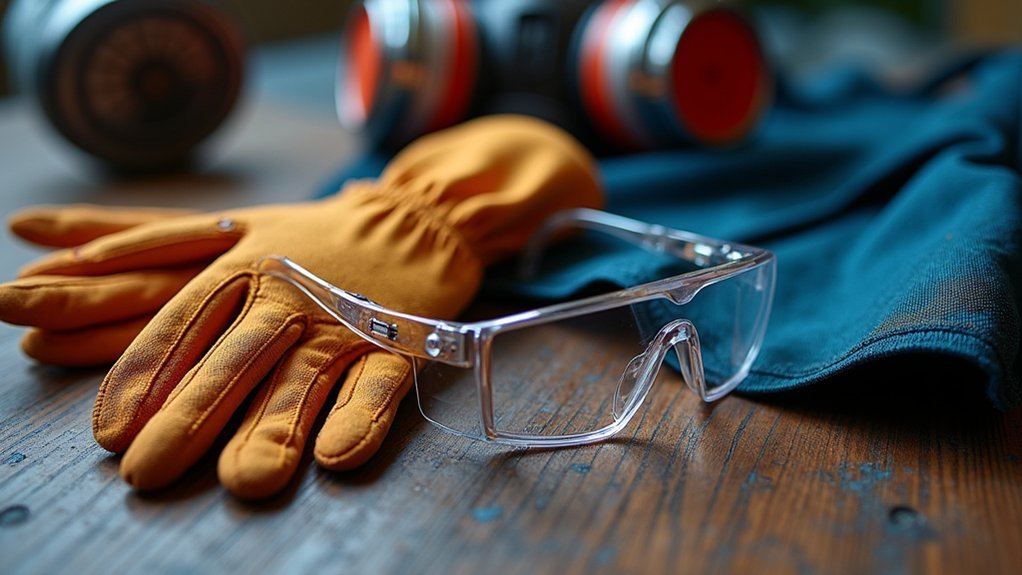
When working with torches for enameling, you’ll need specific protective equipment to safeguard yourself from heat, flying particles, and toxic fumes.
Start with safety glasses to shield your eyes from intense light and debris. Heat-resistant gloves are essential for handling hot materials and tools without burning your hands.
Protect your eyes and hands with proper safety glasses and heat-resistant gloves when torch enameling.
Don’t overlook respiratory protection – wear a dust mask when sifting enamels, though a respirator offers superior filtration against fine particles.
Choose natural fiber clothing like cotton over synthetics that can melt when exposed to heat. Work in a well-ventilated area to prevent fume accumulation.
Keep emergency equipment accessible, including a fire extinguisher and metal bowl of water for quick response to accidents or flare-ups during your enameling process.
Setting Up a Properly Ventilated Workspace
Since toxic fumes and heat are unavoidable byproducts of torch enameling, you’ll need a workspace with excellent ventilation to protect your health.
A well-ventilated workspace protects you from harmful contaminants while maintaining safe air quality throughout your enameling sessions.
Follow these essential steps for proper workspace setup:
- Install a ventilation system like a fume hood or exhaust fan to direct fumes away from your breathing zone.
- Ensure adequate airflow by opening windows and using fans to circulate fresh air continuously.
- Position your torch away from flammable materials to minimize fire risks in ventilated areas.
- Monitor air quality regularly and consider HEPA-filter air purifiers for additional contamination control.
Keep your workspace clean by removing dust and debris that compromise air quality.
Fire Prevention and Emergency Preparedness
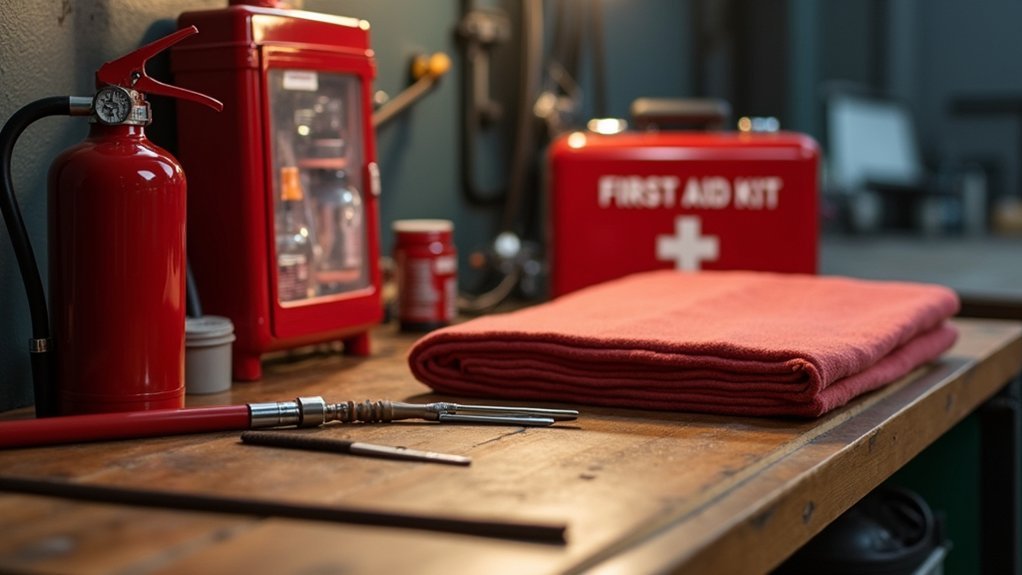
You’ll need specific fire safety equipment readily accessible before you light your torch, including a proper fire extinguisher and metal water bowl for emergencies.
Your workspace must incorporate heat-resistant surfaces and maintain safe distances from any flammable materials to prevent accidental ignition.
You should also establish a clear emergency response plan that outlines exactly what steps you’ll take if a fire occurs during your enameling session.
Essential Fire Equipment
Because torch fires can ignite within seconds, you’ll need specific fire safety equipment positioned strategically around your workspace.
Having the right tools readily available can mean the difference between a minor incident and a serious emergency during torch firing.
Your essential fire safety equipment should include:
- Fire extinguisher – Choose one rated for flammable liquids and electrical fires, positioned within arm’s reach.
- Metal bowl of water – Keep nearby for immediately dousing small flames that may occur.
- Heat-resistant gloves and safety glasses – Wear constantly to protect against burns and flying sparks.
- Heatproof surface – Set up your entire workspace on fire-resistant materials.
Regular inspection and maintenance of all fire safety equipment guarantees everything functions properly when you need it most.
Workspace Heat Prevention
While fire extinguishers and water bowls handle emergencies, preventing heat-related incidents before they start requires careful attention to your workspace setup.
You’ll need a heatproof surface on your worktable to protect flammable materials from torch heat. Your workspace requires proper ventilation to disperse harmful fumes and reduce fire risks.
Wear heat resistant gloves when handling hot materials, and choose natural fiber clothing over synthetic fabrics that melt easily. Roll up sleeves and secure long hair before lighting your torch.
Keep flammable materials at a safe distance from your work area, and never leave your torch unattended.
Following these safety guidelines creates a controlled environment where you can focus on your enameling craft without unnecessary hazards threatening your workspace.
Emergency Response Planning
Even with proper workspace setup, accidents can happen quickly when working with torches, making a detailed emergency response plan essential for your safety.
You’ll need extensive preparation to handle emergencies effectively in your well-ventilated workspace.
Your emergency response plan should include these critical components:
- Fire extinguisher placement – Position Class ABC extinguishers within easy reach and maintain them regularly.
- Designated fire safety zone – Create a heat-resistant area around your torch operations, free from flammable materials.
- Training requirements – Master proper torch handling techniques and emergency procedures for extinguishing fires.
- Medical preparedness – Keep a fully stocked first aid kit accessible for treating burns or injuries.
Know your exit routes and practice emergency procedures regularly to guarantee quick, effective responses when seconds count.
Safe Torch Handling and Operation Techniques
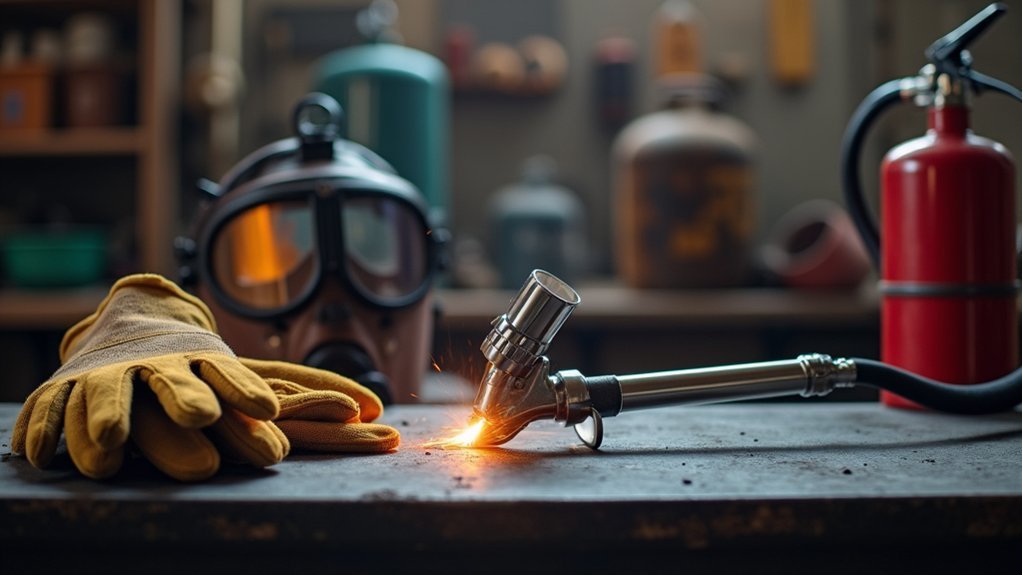
Mastering proper torch ignition sets the foundation for safe enamel work and prevents dangerous accidents before they start.
You’ll need to control heat distribution carefully, using smooth circular motions beneath the firing screen to guarantee even heating without overexposing any single area.
These fundamental techniques protect both your project and your safety while maintaining consistent results throughout the enameling process.
Proper Torch Ignition
Before you strike that first flame, remember that proper torch ignition sets the foundation for every safe enameling session. Taking precautions during this critical moment prevents accidents and establishes secure working conditions.
Follow these essential ignition steps:
- Position your torch on a stable, heatproof surface before lighting to prevent tipping or unexpected movement.
- Use a long lighter or striker to maintain safe distance between your fingers and the flame.
- Point the torch away from your body and any flammable materials to minimize fire hazards.
- Verify all connections are tight and inspect for leaks or damage beforehand.
Keep your workspace clear of clutter and flammable items. This creates room for safe operation and guarantees you can quickly access emergency equipment if needed.
Heat Distribution Control
Once you’ve safely ignited your torch, controlling heat distribution becomes your next priority for achieving professional enameling results.
Maintain a safe distance between the torch flame and enamel piece to prevent direct contact that can cause burning or uneven heating. Move your torch in circular motions to evenly distribute heat across the surface, eliminating concentrated hotspots during firing enamels.
Keep your flame at a bushy setting similar to annealing, providing gentle fusion without excessive temperatures. You’ll need to adjust the flame intensity based on your enamel’s type and thickness, as different materials have varying heat requirements.
Practice controlling your torch while observing the enamel’s response to develop instincts for achieving desired finishes and avoid over-firing.
Protective Clothing and Natural Fiber Requirements
When torch enameling, your clothing choices directly impact your safety since synthetic materials can melt onto your skin and cause severe burns.
Natural fiber clothing like cotton or linen provides essential protection against fire hazards during the enameling process.
Your protective clothing setup should include these critical elements:
- Natural fiber garments – Choose cotton or linen shirts and pants that won’t melt when exposed to heat
- Leather apron – Wear one to shield your torso from sparks and intense heat generated by the torch
- Heat-resistant gloves – Keep them within reach to safely handle hot tools and materials after firing
- Safety glasses – Protect your eyes from harmful fumes, flying particles, and bright light
Roll up long sleeves and tie back hair to prevent catching fire or equipment entanglement.
Managing Enamel Powder Exposure and Dust Control

Since enamel powders create fine particles that can harm your respiratory system, you must take immediate precautions to control dust exposure in your workspace.
Always wear a dust mask or respirator when you sift enamels to prevent inhaling dangerous particles. Work in a well-ventilated area to minimize exposure to dust and fumes during the enameling process.
Protect your lungs by wearing proper respiratory protection and ensuring adequate ventilation when working with enamel powders.
Place recycled paper under your workspace to catch excess enamel and simplify cleanup while reducing contamination risks. Clean your work area regularly to remove spilled enamel powders, maintaining both safety and organization.
Use proper sifting techniques with appropriate sifters to control powder release, which minimizes airborne particles. These essential safety measures protect your health while ensuring efficient enamel application.
Heat Management and Burn Prevention Strategies
You’ll need to master proper torch distance and emergency response protocols to prevent serious burns while working with enamel.
Maintaining the right distance from your flame isn’t just about technique—it’s your primary defense against accidental contact with intense heat.
When things go wrong, you’ll want established emergency protocols that can mean the difference between a minor incident and a trip to the hospital.
Proper Torch Distance
Maintaining proper torch distance stands as one of the most critical factors in successful enamel firing and personal safety. You’ll need to keep your torch approximately 2 to 4 inches from the enamel surface to achieve even heating without causing damage.
Follow these essential distance guidelines:
- Use a bushy flame that disperses heat evenly across your piece.
- Move the torch in circular motions to prevent concentrated heat spots.
- Monitor the piece closely for visual cues of proper melting stages.
- Employ a heatproof surface with stable supports for your workspace.
Adjust your torch distance based on how the enamel responds during firing. This careful attention prevents overheating, burning, and accidental burns while ensuring professional results in your enameling projects.
Emergency Response Protocols
Emergency preparedness becomes your lifeline when working with high-temperature enameling torches.
You’ll need immediate access to a fire extinguisher positioned within arm’s reach of your workspace. Keep a metal bowl filled with water nearby to quickly cool hot tools and workpieces during emergency situations.
Always wear heat-resistant gloves and safety glasses as your primary defense against unexpected accidents.
If burns occur, don’t hesitate—immediately place the affected area under running water for 10-15 minutes. This vital step minimizes tissue damage and reduces pain.
Remove all flammable materials from your work area before beginning any project.
Know your emergency protocols before you start working, not when disaster strikes. Quick, practiced responses can prevent minor incidents from becoming serious injuries.
Proper Tool Maintenance and Handling Procedures
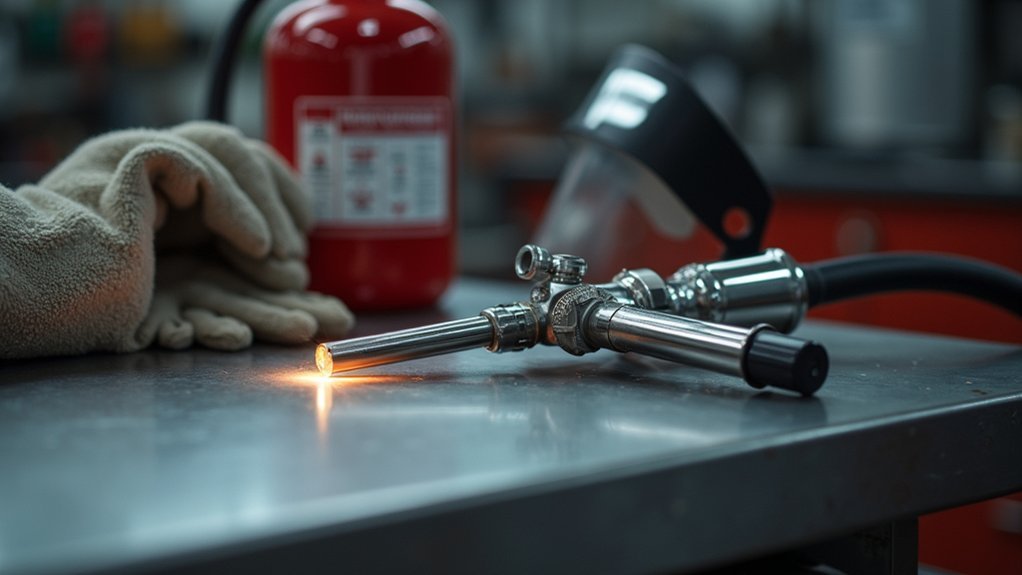
When you’re working with enamel torches, proper tool maintenance forms the foundation of both safety and successful results.
You’ll need to establish consistent practices that protect both your materials and working environment from contamination.
Essential maintenance procedures include:
- Clean tools regularly with quality metal cleaner to guarantee ideal enamel adhesion and prevent cross-contamination between projects.
- Store enamel powders in labeled, airtight containers to prevent moisture absorption and maintain their quality over time.
- Use spatulas carefully when handling powders to minimize dust creation and reduce inhalation hazards.
- Inspect safety equipment like gloves and safety glasses before each session to confirm they’re functioning properly.
Implementing routine checks before starting new projects helps maintain clean tools and creates a safer workspace for consistent, professional results.
Workspace Organization and Material Storage Safety
A well-organized workspace considerably reduces your risk of accidents and contamination when working with enamel torches. Proper workspace organization starts with maintaining a clean workspace that prevents cross-contamination of enamels and materials.
You’ll want to store enamels in labeled, airtight containers to protect them from moisture and contamination, safeguarding their longevity.
Place recycled paper under your work area to catch excess enamel and facilitate easy cleanup while minimizing inhalation risks from fine particles. Regular cleaning of tools and supplies prevents dust buildup that could pose health hazards.
Keep essential safety equipment like gloves and safety glasses within easy reach. Most importantly, guarantee your workspace is well-ventilated to reduce exposure to enamel dust during the torching process.
Firescale and Chemical Hazard Management
Beyond maintaining an organized workspace, you’ll face additional safety challenges from firescale formation and chemical hazards during the enameling process.
Firescale develops when oxidation occurs on exposed metal surfaces during heating, creating potential contamination issues.
To protect yourself from these hazards, follow these essential steps:
- Maintain a clean workspace and regularly inspect tools to prevent unwanted chemical reactions
- Work in a well-ventilated area and wear a particulate mask when sifting enamels to avoid inhaling harmful dust
- Keep a fire extinguisher within easy reach during torch firing operations
- Clean metal thoroughly before firing and brush off remaining scale after cooling
These precautions minimize exposure to toxic fumes and particles while preventing contamination that could compromise your enamel work’s quality and safety.
Frequently Asked Questions
Is Enamel Jewelry Safe to Wear?
Yes, you can safely wear enamel jewelry when it’s made with lead-free enamels and properly fired. You’ll want to choose pieces using safe metals like fine silver, and you should maintain them regularly.
How to Counter Enamel?
Clean your metal surface thoroughly, then apply counter enamel to the back side. Fire it first to the sugar stage before adding your topcoat. Use compatible enamel types and allow proper cooling between firings.
Is Enamel Dust Toxic?
Enamel dust can be toxic, especially if you’re using leaded enamels. You’ll face respiratory risks from inhaling particles and potential lead poisoning. Always choose lead-free options when possible for safer enameling work.
How to Torch Fire Enamel?
Place your prepared metal piece on a firing screen, then move the butane torch in circular motions underneath. Heat evenly while watching the enamel progress through sugar, orange peel, and full fuse stages.
In Summary
You’ll stay safe while torch enameling by consistently wearing proper PPE, maintaining adequate ventilation, and keeping fire safety equipment nearby. Don’t forget to wear natural fiber clothing, organize your workspace efficiently, and handle tools with care. You’re protecting yourself from burns, toxic fumes, and fire hazards when you follow these essential safety measures. Remember, you can’t compromise on safety—it’s what separates successful enameling from dangerous experimentation.

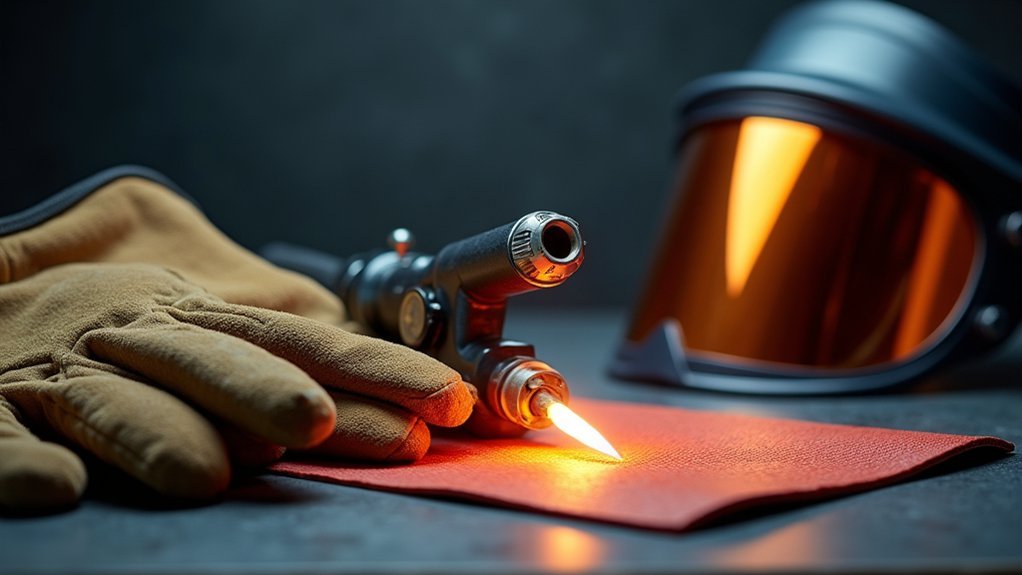



Leave a Reply